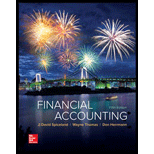
Concept explainers
(a)
Calculate
(a)
Explanation of Solution
Straight-line method: Under the straight-line method of depreciation, the same amount of depreciation is allocated every year over the estimated useful life of an asset. The following is the formula to calculate the depreciation.
Determine depreciation expense, accumulated depreciation, and book value at the end of sixth year under straight line depreciation method.
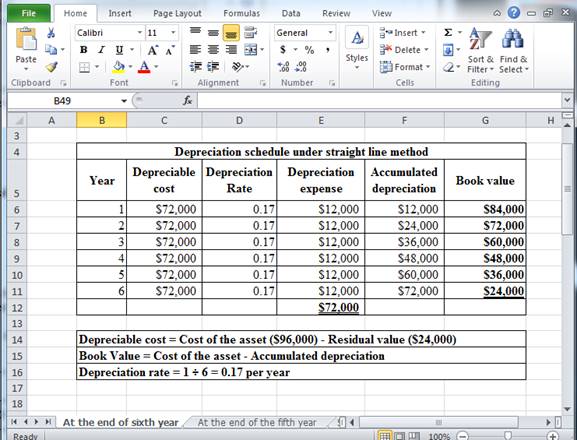
Table (1)
Hence, the depreciation expense, accumulated depreciation, and book value at the end of the sixth year, under straight line method are $12,000, $72,000 and $24,000 respectively.
Record the adjusting entry for depreciation expense at the end of the third year under straight line depreciation method.
| Date | Accounts title and explanation | Post Ref. |
Debit ($) |
Credit ($) |
| Depreciation expense – Equipment (Refer table (1)) | 12,000 | |||
| Accumulated depreciation -Equipment | 12,000 | |||
| (To record the depreciation expense) |
Table (2)
To record the adjusting entry for depreciation expense at the end of the third year:
- Depreciation expense is an expense (decreases the
stockholders’ equity ) and it is increased by $12,000. Therefore, debit depreciation account with $12,000. - Accumulated depreciation is a contra-asset. Increase in the accumulated depreciation account decreases the related asset account. Therefore, credit accumulated depreciation account with $12,000.
Working Note:
The above calculation is computed using spreadsheet as follows:
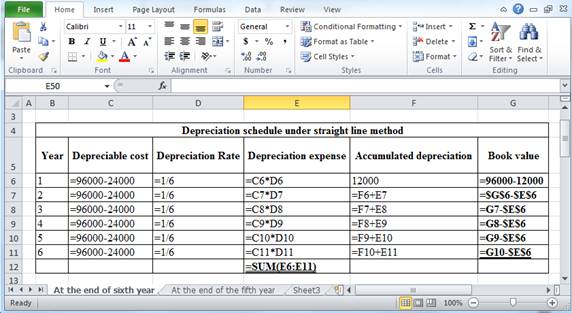
Table (3)
(b)
Calculate depreciation expense, accumulated depreciation, and book value for each of the six years using double-declining-balance method and record the adjusting entry for depreciation expense at the end of the third year under each method.
(b)
Explanation of Solution
Double-declining-balance method: The depreciation method which assumes that the consumption of economic benefits of long-term asset is high in the early years but gradually declines towards the end of its useful life is referred to as double-declining-balance method.
Determine depreciation expense, accumulated depreciation, and book value at the end of sixth year under double declining balance method.
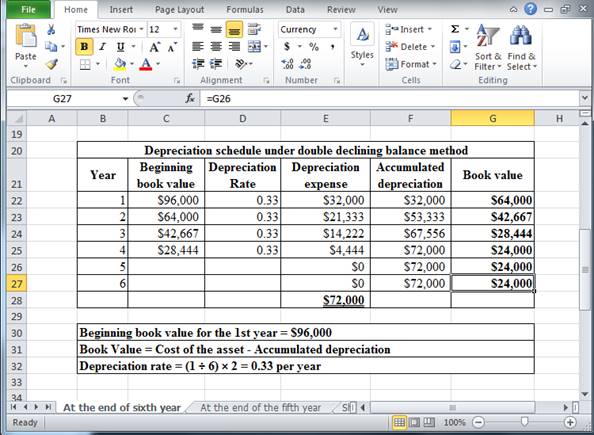
Table (4)
Hence, the depreciation expense, accumulated depreciation, and book value at the end of the sixth year, under double declining balance method are $0, $72,000 and $24,000 respectively.
Record the adjusting entry for depreciation expense at the end of the third year under double declining balance method.
| Date | Accounts title and explanation | Post Ref. |
Debit ($) |
Credit ($) |
| Depreciation expense – Equipment (Refer table (4)) | 14,222 | |||
| Accumulated depreciation -Equipment | 14,222 | |||
| (To record the depreciation expense) |
Table (5)
To record the adjusting entry for depreciation expense at the end of the third year:
- Depreciation expense is an expense (decreases the stockholders’ equity) and it is increased by $14,222. Therefore, debit depreciation account with $14,222.
- Accumulated depreciation is a contra-asset. Increase in the accumulated depreciation account decreases the related asset account. Therefore, credit accumulated depreciation account with $14,222.
Working Note:
The above calculation is computed using spreadsheet as follows:
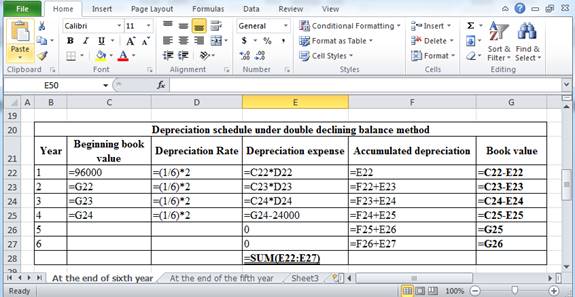
Table (6)
(c)
Calculate depreciation expense, accumulated depreciation, and book value for each of the six years using activity-based method and record the adjusting entry for depreciation expense at the end of the third year under each method.
(c)
Explanation of Solution
Activity based method: In this method of depreciation, the amount of depreciation is charged based on the units of production each year.
Determine depreciation expense, accumulated depreciation, and book value at the end of sixth year under activity based method.
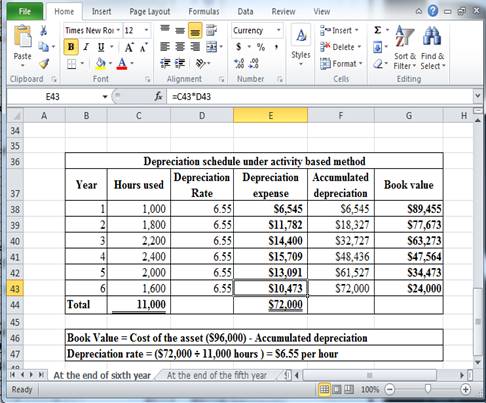
Table (7)
Hence, the depreciation expense, accumulated depreciation, and book value at the end of the sixth year, under activity based method are $10,473, $72,000 and $24,000 respectively.
Record the adjusting entry for depreciation expense at the end of the third year under activity based method.
| Date | Accounts title and explanation | Post Ref. |
Debit ($) |
Credit ($) |
| Depreciation expense – Equipment (Refer table (7)) | 14,400 | |||
| Accumulated depreciation -Equipment | 14,400 | |||
| (To record the depreciation expense) |
Table (8)
To record the adjusting entry for depreciation expense at the end of the third year:
- Depreciation expense is an expense (decreases the stockholders’ equity) and it is increased by $14,400. Therefore, debit depreciation account with $14,400.
- Accumulated depreciation is a contra-asset. Increase in the accumulated depreciation account decreases the related asset account. Therefore, credit accumulated depreciation account with $14,400.
Working Note:
The above calculation is computed using spreadsheet as follows:
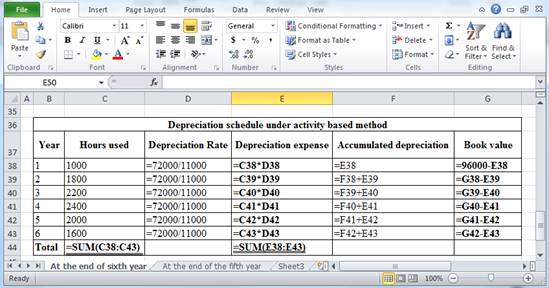
Table (9)
Calculate depreciation expense, accumulated depreciation, and book value for each of the fifth years using (a) straight-Line, (b) double-declining-balance, and (c) activity-based if the company had initially estimated the residual value to be $16,000 and the useful life to be five years.
Explanation of Solution
(a)
Straight-line method: Under the straight-line method of depreciation, the same amount of depreciation is allocated every year over the estimated useful life of an asset. The following is the formula to calculate the depreciation.
Determine depreciation expense, accumulated depreciation, and book value at the end of sixth year under straight line depreciation method.
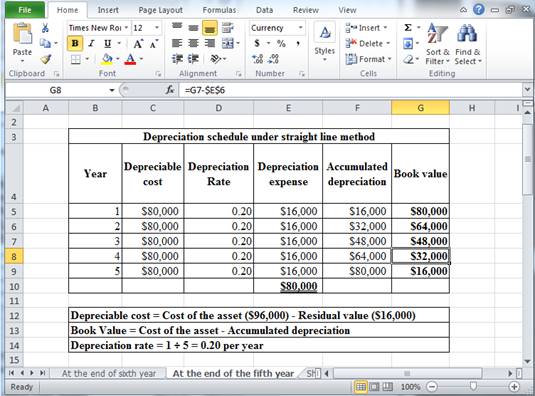
Table (10)
Hence, the depreciation expense, accumulated depreciation, and book value at the end of the sixth year, under straight line method are $16,000, $80,000 and $16,000 respectively.
Record the adjusting entry for depreciation expense at the end of the third year under straight line depreciation method.
| Date | Accounts title and explanation | Post Ref. |
Debit ($) |
Credit ($) |
| Depreciation expense – Equipment (Refer table (10)) | 16,000 | |||
| Accumulated depreciation -Equipment | 16,000 | |||
| (To record the depreciation expense) |
Table (11)
To record the adjusting entry for depreciation expense at the end of the third year:
- Depreciation expense is an expense (decreases the stockholders’ equity) and it is increased by $16,000. Therefore, debit depreciation account with $16,000.
- Accumulated depreciation is a contra-asset. Increase in the accumulated depreciation account decreases the related asset account. Therefore, credit accumulated depreciation account with $16,000.
Working Note:
The above calculation is computed using spreadsheet as follows:
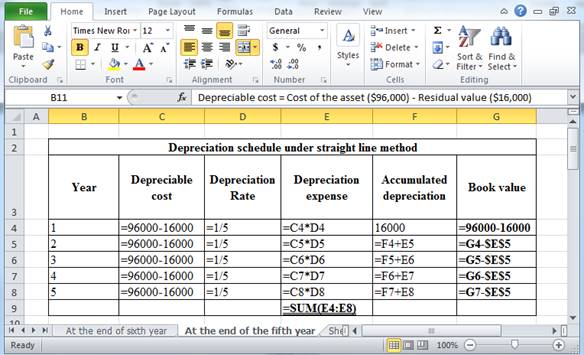
Table (12)
(b)
Double-declining-balance method: The depreciation method which assumes that the consumption of economic benefits of long-term asset is high in the early years but gradually declines towards the end of its useful life is referred to as double-declining-balance method.
Determine depreciation expense, accumulated depreciation, and book value at the end of sixth year under double declining balance method.
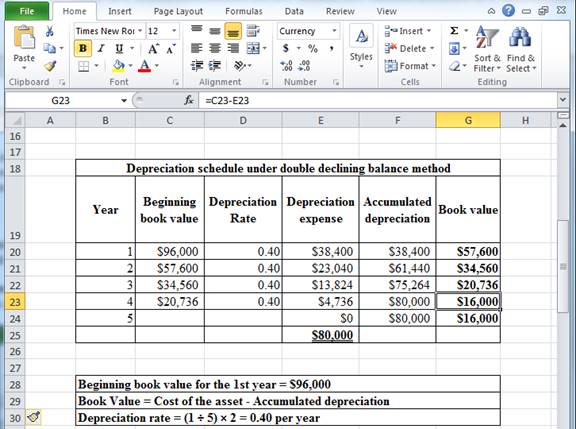
Table (13)
Hence, the depreciation expense, accumulated depreciation, and book value at the end of the fifth year, under s double declining balance method are $0, $80,000 and $16,000 respectively.
Record the adjusting entry for depreciation expense at the end of the third year under double declining balance method.
| Date | Accounts title and explanation | Post Ref. |
Debit ($) |
Credit ($) |
| Depreciation expense – Equipment (Refer table (13)) | 13,824 | |||
| Accumulated depreciation -Equipment | 13,824 | |||
| (To record the depreciation expense) |
Table (14)
To record the adjusting entry for depreciation expense at the end of the third year:
- Depreciation expense is an expense (decreases the stockholders’ equity) and it is increased by $13,824. Therefore, debit depreciation account with $13,824.
- Accumulated depreciation is a contra-asset. Increase in the accumulated depreciation account decreases the related asset account. Therefore, credit accumulated depreciation account with $13,824.
Working Note:
The above calculation is computed using spreadsheet as follows:
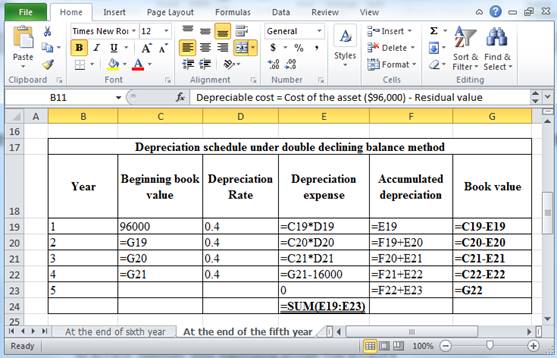
Table (15)
(c)
Activity based method: In this method of depreciation, the amount of depreciation is charged based on the units of production each year.
Determine depreciation expense, accumulated depreciation, and book value at the end of sixth year under activity based method.
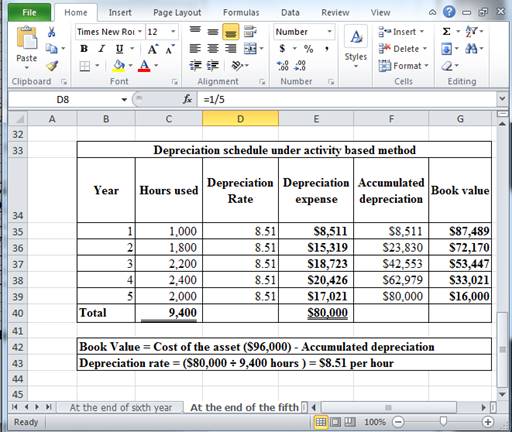
Table (16)
Hence, the depreciation expense, accumulated depreciation, and book value at the end of the fifth year, under activity based method are $17,021, $80,000 and $16,000 respectively.
Record the adjusting entry for depreciation expense at the end of the third year under activity based method.
| Date | Accounts title and explanation | Post Ref. |
Debit ($) |
Credit ($) |
| Depreciation expense – Equipment (Refer table (16)) | 18,723 | |||
| Accumulated depreciation -Equipment | 18,723 | |||
| (To record the depreciation expense) |
Table (17)
To record the adjusting entry for depreciation expense at the end of the third year:
- Depreciation expense is an expense (decreases the stockholders’ equity) and it is increased by $18,723. Therefore, debit depreciation account with $18,723.
- Accumulated depreciation is a contra-asset. Increase in the accumulated depreciation account decreases the related asset account. Therefore, credit accumulated depreciation account with $18,723.
Working Note:
The above calculation is computed using spreadsheet as follows:
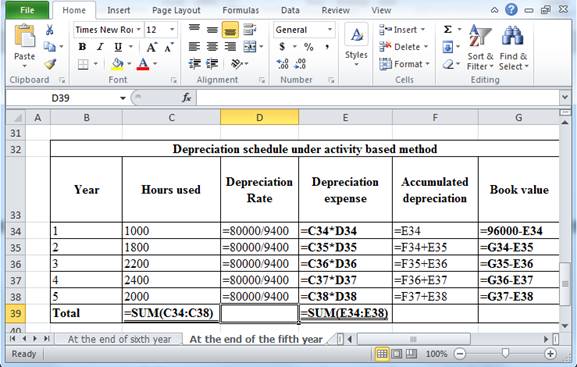
Table (18)
Want to see more full solutions like this?
Chapter 7 Solutions
FINANCIAL ACCOUNTING- LL W CONNECT PKG
- Mark received 10 ISOs (each option gives him the right to purchase 14 shares of Hendricks Corporation stock for $6 per share) at the time he started working for Hendricks Corporation five years ago, when Hendricks's stock price was $5 per share. Now that Hendricks's share price is $35 per share, Mark intends to exercise all of his options and hold all of his shares for more than one year. Assume that more than a year after exercise, Mark sells the stock for $35 a share. Note: Enter all amounts as positive values. Leave no answers blank. Enter zero if applicable. b. What are Hendricks's tax consequences on the grant date, the exercise date, and the date Mark sells the shares? Grant date Exercise date Sale date Tax Benefitarrow_forwardYost received 300 NQOs (each option gives Yost the right to purchase 10 shares of Cutter Corporation stock for $19 per share). At the time he started working for Cutter Corporation three years ago, Cutter's stock price was $19 per share. Yost exercised all of his options when the share price was $38 per share. Two years after acquiring the shares, he sold them at $59 per share. Note: Input all amounts as positive values. Leave no answer blank. Enter zero if applicable. c. Assume that Yost is "cash poor" and needs to engage in a same-day sale in order to buy his shares. Due to his belief that the stock price is going to increase significantly, he wants to maintain as many shares as possible. How many shares must he sell in order to cover his purchase price and taxes payable on the exercise? Number of shares to be soldarrow_forwardMark received 10 ISOs (each option gives him the right to purchase 14 shares of Hendricks Corporation stock for $6 per share) at the time he started working for Hendricks Corporation five years ago, when Hendricks's stock price was $5 per share. Now that Hendricks's share price is $35 per share, Mark intends to exercise all of his options and hold all of his shares for more than one year. Assume that more than a year after exercise, Mark sells the stock for $35 a share. Note: Enter all amounts as positive values. Leave no answers blank. Enter zero if applicable. a. What are Mark's taxes due on the grant date, the exercise date, and the date he sells the shares, assuming his ordinary marginal rate is 32 percent and his long-term capital gains rate is 15 percent? Grant date Exercise date Sale date Taxes Duearrow_forward
- On January 1, year 1, Dave received 2,500 shares of restricted stock from his employer, RRK Corporation. On that date, the stock price was $13 per share. On receiving the restricted stock, Dave made the 83(b) election. Dave's restricted shares will vest at the end of year 2. He intends to hold the shares until the end of year 4, when he intends to sell them to help fund the purchase of a new home. Dave predicts the share price of RRK will be $33 per share when his shares vest and $54 per share when he sells them. Assume that Dave's price predictions are correct, and answer the following questions: Note: Leave no answers blank. Enter zero if applicable. Round your final answer to the nearest whole dollar value. Enter all amounts as positive values. b. What are the tax consequences of these transactions to RRK? Grant date Tax consequences Vesting date $ 0 Sale date $ 0arrow_forwardMeg works for Freedom Airlines in the accounts payable department. Meg and all other employees receive free flight benefits (for the employee, family, and 10 free buddy passes for friends per year) as part of its employee benefits package. If Meg uses 15 flights with a value of $6,975 this year, how much must she include in her compensation this year? Amount includedarrow_forwardSeiko's current salary is $101,000. Her marginal tax rate is 32 percent, and she fancies European sports cars. She purchases a new auto each year. Seiko is currently a manager for Idaho Office Supply. Her friend, knowing of her interest in sports cars, tells her about a manager position at the local BMW and Porsche dealer. The new position pays $84,600 per year, but it allows employees to purchase one new car per year at a discount of $19,400. This discount qualifies as a nontaxable fringe benefit. In an effort to keep Seiko as an employee, Idaho Office Supply offers her a $10,500 raise. Answer the following questions about this analysis. a. What is the annual after-tax cost to Idaho Office Supply if it provides Seiko with the $10,500 increase in salary? Note: Ignore payroll taxes. After-tax costarrow_forward
- Required information [The following information applies to the questions displayed below.] Nicole's employer, Poe Corporation, provides her with an automobile allowance of $42,000 every other year. Her marginal tax rate is 32 percent. Answer the following questions relating to this fringe benefit. b. What is Poe's after-tax cost of providing the auto allowance? > Answer is complete but not entirely correct. After-tax cost $ 28,560arrow_forward100%, equity, ending inventory. On January 1, 2015, 100% of the outstanding stock of Solo Company was purchased by Plato Corporation for $3,300,000. At that time, the book value of Solo’s net assets equaled $3,000,000. The excess was attributable to equipment with a 10-year life. The following trial balances of Plato Corporation and Solo Company were prepared on December 31, 2015: Plato Corporation Solo Company Cash 735000 37000 Accounts Receivable 400000 365000 Inventory 600000 275000 Property,Plato and Equipment 4000000 2300000 Investment in Solo company 3510000 Accounts Payable (35000) (100000) Common stock ($10 par) (1000000) (400000) Paid-in capital in excess of par (1500000) (200000) Retained earnings, Jan 1, 2015 (5,500,000) (2,400,000) Sales (12,000,000) (1,000,000) Cost of goods sold 7,000,000 750,000 Other expenses 4,000,000 40,000 Subsidiary income…arrow_forwardMarino Snacks Co. had its highest total cost of $84,000 in July and its lowest total cost of $60,000 in November. The company produces a single product. Production volume was 14,000 units in July and 9,000 units in November. What is the fixed cost per month? Answerarrow_forward
- I need help with this financial accounting question using the proper financial approach.arrow_forwardE4-8 Plevin Company ended its fiscal year on July 31, 2014. The company's adjusted trial balance as of the end of its fiscal year is shown below. PLEVIN COMPANY Adjusted Trial Balance July 31, 2014 (b) Tota Journal entries, closing (LO 2, No. Account Titles Debit Credit 101 Cash $ 9,840 112 Accounts Receivable 8,780 157 Equipment 15,900 158 Accumulated Depreciation-Equip. $ 7,400 201 Accounts Payable 4,220 208 Unearned Rent Revenue 1,800 301 Owner's Capital 45,200 306 Owner's Drawings 16,000 400 Service Revenue 64,000 6,500 429 Rent Revenue 711 Depreciation Expense 8,000 726 Salaries and Wages Expense 55,700 732 Utilities Expense 14,900 $129,120 $129,120 Instructions (a) Prepare the closing entries using page J15. (b) Post to Owner's Capital and No. 350 Income Summary accounts. (Use the three-column form.) (c) Prepare a post-closing trial balance at July 31.arrow_forwardGeneral accounting questionarrow_forward

 AccountingAccountingISBN:9781337272094Author:WARREN, Carl S., Reeve, James M., Duchac, Jonathan E.Publisher:Cengage Learning,
AccountingAccountingISBN:9781337272094Author:WARREN, Carl S., Reeve, James M., Duchac, Jonathan E.Publisher:Cengage Learning, Accounting Information SystemsAccountingISBN:9781337619202Author:Hall, James A.Publisher:Cengage Learning,
Accounting Information SystemsAccountingISBN:9781337619202Author:Hall, James A.Publisher:Cengage Learning, Horngren's Cost Accounting: A Managerial Emphasis...AccountingISBN:9780134475585Author:Srikant M. Datar, Madhav V. RajanPublisher:PEARSON
Horngren's Cost Accounting: A Managerial Emphasis...AccountingISBN:9780134475585Author:Srikant M. Datar, Madhav V. RajanPublisher:PEARSON Intermediate AccountingAccountingISBN:9781259722660Author:J. David Spiceland, Mark W. Nelson, Wayne M ThomasPublisher:McGraw-Hill Education
Intermediate AccountingAccountingISBN:9781259722660Author:J. David Spiceland, Mark W. Nelson, Wayne M ThomasPublisher:McGraw-Hill Education Financial and Managerial AccountingAccountingISBN:9781259726705Author:John J Wild, Ken W. Shaw, Barbara Chiappetta Fundamental Accounting PrinciplesPublisher:McGraw-Hill Education
Financial and Managerial AccountingAccountingISBN:9781259726705Author:John J Wild, Ken W. Shaw, Barbara Chiappetta Fundamental Accounting PrinciplesPublisher:McGraw-Hill Education





